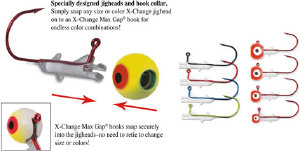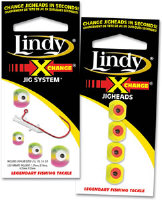Follow the Fish for Walleye Success
Jul 23rd, 2009 by OutdoorsFIRST
Modified Jul 23rd, 2009 at 12:00 AM
When it comes to walleye fishing, nothing is more exciting than tossing a jig into the shallows during springtime. But as early spring gives way to the post-spawn patterns of late spring and the big fish move deeper, I’m not ready to give up the jigs. So how can the dedicated jig fisherman stay at it all year? That is exactly the question that I took to seasoned walleye angler Ted Takasaki. His answers gave me all the information I needed for a full season of jigging in open water.
 |
|
|
Lindy X-Change Jig
|
In order for time on the water to consistently translate to fish in the freezer, an angler should learn the habits of the fish they intend to catch. Walleyes will start out on shallow water flats before slowly making the transition to weed lines, and then on to the tips of main lake points before moving to deeper humps and reefs as the water continues to warm. They then move down to the depths when the lake turns over in the fall. How is an angler to keep track?
“No matter where you go, walleyes are structure- and current-oriented,” explains Takasaki. “There are a few key features that I look for when searching new water and I especially key on areas that contain two or more of these features in the same place.”
In early spring, the most common features Takasaki keys on are bottom composition, depth and water movement. Females move up to spawn on areas with hard bottoms – usually sand, loose gravel or clay – in water that is 10 feet deep or less. Though most lakes across the Midwest have several areas meeting this description, the key is often water movement.
“In rivers, current breaks, bottle necks and bends create a lot of places worth checking out, but in lakes the spots are often smaller and more precise,” Takasaki says. “Any ditches, creeks or other drainages where water is moving into the lake is a likely starting point. In lakes without these features, walleyes will stack up on windblown shorelines and shallow reefs.”
 |
|
As the water warms in mid spring, the bigger females move off their spawning grounds and out to deeper water where they can rest. Emerging weeds begin to form lines on which the fish will locate. The depth of these weeds, and thus the fish, is largely determined by water clarity as clearer water allows sunlight to penetrate further so that plants can grow. The other factor is bottom composition; weeds generally grow in areas where the bottom has changed from hard to soft.
Pitching jigs to these emerging weed lines and to rocky points this time of year are two common fishing methods. Anglers also experience pretty good luck dragging or “long-lining” jigs along the bottom on depth breaks anywhere from 5- to 10-feet.
Fishing during this post-spawn period can be spectacular. Ted pitches 1/8 ounce X-Change jigs from Lindy into the shallows to catch the eating-size males that remain there, and switches to a ¼ or 3/8 ounce head to vertical jig for the big females laying out deeper. Slow trolling is usually accomplished with a 1/8 to ¼ ounce jig. The best areas are found at the confluence of multiple edges: shallow to deep, dirty to clean water, hard to soft bottom, weed lines or any other type of edge, especially along windblown points or shorelines.
As spring gives way to summer and water temperatures enter the 60 – 70 degree range, walleyes move out to areas from 10- to 25-feet deep in most lakes. The vegetation lines are now well established and hungry fish can be found in various spots in and around them. Takasaki takes two primary approaches to these weeds. First he casts beyond the weed line and uses a fast retrieve across the top of the weeds to entice the active fish to come up and take a swing. When that slows down, he makes another toss into the weeds and allows the jig to settle. This method allows him to thoroughly work an area and he lets the fish tell him what they want.
Long points also become very productive as they provide natural drop-offs where big walleyes can move up shallow to feed during low-light conditions. Dragging a jig along the length of these points allows anglers to pinpoint the depth the walleyes are holding, then go back to vertical jig those depth breaks. Rock piles and underwater humps that are often found farther out from these points are also dynamite spots to find fish in the summer. Again, Ted recommends a combination of dragging and vertical jigging to catch more fish.
The first crisp wind of September indicates that fall fishing is finally here. As if on cue, the lakes begin to turn and walleyes move deep, making them difficult to target with jigs. In lakes where the water is stained, however, they stay within range. Vertical jigging is king this time of year. The tips of points and main lake humps become the hot spots and quality electronics are a must. It is extremely important now to use enough weight to maintain bottom contact with a jig. Though this is preferred at all times of the year, deeper fish make it even more important in the fall.
“Your line will tell you whether you are on the bottom or not,” says Takasaki. “It is absolutely critical to feel what your jig is doing down there.”
Whatever the time of year may be, there a few tips that will make you jig fishing much more productive. After you know what the fish are doing, the next question must be, “What is making the fish bite?” Depth, action, color and speed are the keys to understanding this part of the equation.
Speed and depth are the two easiest to figure out and the most often overlooked aspects of jig fishing. If these two factors are wrong, an angler can change the color and action all day long and still not catch fish. Depth is pretty straightforward. Start in shallow water and move out deep, then back shallow. Follow this zigzagging path along a likely looking bank and pay attention to the depth of your jig when the strikes come. Vary your speed by setting your trolling motor somewhere in the middle and adjusting up or down to see where the most strikes come. When you figure this part out it is time to adjust your color.
“One person should always have hot yellow tied on,” says Takasaki. “That’s the number one color jig for walleye fishing. Another person might fish a bright green, pink or orange and a third person should use either a metallic or dark colored jig head.” When there are only one or two people in the boat, the X-Change Jig System allows quick changes between colors so anglers can get a quick idea of which color is hot. As cloud cover and wind change the amount of penetrating sunlight, the ideal color can change throughout the day, so anglers should be prepared to keep experimenting to stay on the walleye ‘hit list.'”
The last factor, action, is determined in part by the time of year. As discussed earlier, different seasons and conditions call for different approaches – from pitching to dragging to vertical jigging. The other part of the action consists of the variances the angler uses within each approach. Jigs pitched into the shallows are often most effective when they are slowly dragged along the bottom, but at certain times pumping these jigs up and down during the retrieve can entice more strikes. Likewise, jigs fished vertically can be slowly lifted up and down or snapped sharply. Play around with different retrieves as you go and pay attention to what the jig is doing when a fish eats it.
The only question remaining is that of what to put on the jig. According to Takasaki, minnows are most popular in the spring and fall, followed by crawlers and leeches. In the summer, crawlers are the number one choice, with leeches and minnows coming second and third, respectively. Walleyes will eat any of the three and experimenting with different types of bait often pays big dividends. A growing trend among walleye anglers is using plastic grubs, ringworms and worms on a jig. This cuts down on cost in some instances and works especially well when water is too cold to employ nightcrawlers or leeches and on backwater canoe trips where storage space is at a premium.
Whatever your preferred walleye tactic may be, jigs have a place in your tackle box all season long – any time, any place. Whether you’re a new fisherman or a hardcore springtime jigger, be sure to pack along a selection of hooks and different sizes and colors of heads to jig up walleyes through each transition of the year.
See a related video here:
http://walleye.outdoorsfirst.com/watch.asp?id=1763